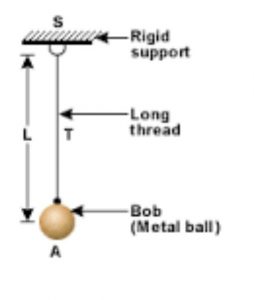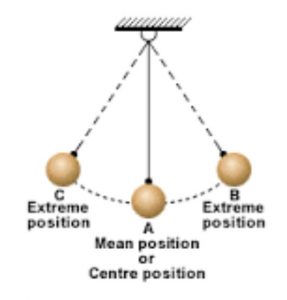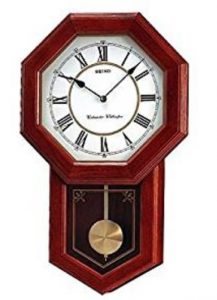Question 1 What is simple pendulum?
Question 2 Define the term time period, length of pendulum, oscillations and amplitude of a pendulum?
Question 3 What are digital quartz clock?
Question 4 What are non-digital quartz clock?
Question 5 What are atomic clocks?
Question 6 What are pendulum clocks?
Contents
Simple Pendulum
A simple pendulum consists of a small metal ball (called bob) suspended by a long thread from a rigid support, such that the bob is free to swing back and forth.
The motion of pendulum was first studied by Galileo.
A pendulum completes every swing (or every oscillation) in exactly the same time, provided its length is kept constant.
The time period of oscillation of a given pendulum is constant.
A simple pendulum can be made by tying about one metre long thread to a small metal ball (called bob) and suspending it from a rigid support so that the bob is free to swing When the pendulum is at rest, then its bob is at the mean position. If the bob of this pendulum is pulled to one side and then released, it will begin to oscillate to-and-fro (back and forth) like a swing.
Initially the bob is at the mean position A. Now, suppose the bob is pulled a little to the right side to position-B-and then released. It will be seen to come back and move on to position C, at an equal distance on the other side of the mean position A, and then go on repeating this back and forth motion between the two extreme positions B and C. And we say that the simple pendulum is oscillating (or vibrating).
The to-and-fro motion of a simple pendulum is an example of periodic motion (or oscillatory motion).
(1) Length of Pendulum
The length of thread from the point of suspension to the centre of bob, is called length of pendulum. The time-period of a pendulum depends on its length. As the length of a pendulum is increased, its time-period also increases. The time-period of a pendulum of given length is constant.
(2) Oscillations
One complete to-and-fro movement of the pendulum bob is called an oscillation.
One oscillation can be counted starting from one of the extreme positions of the bob or from the mean position.
The motion of pendulum bob from its extreme position B to C, and back to B is called one oscillation. The motion of bob from its mean position A to B, then from B to C, and back to A is also equal to one oscillation.
(3) Time-Period
The time taken by pendulum bob to make one complete oscillation is called time period of the pendulum. The time taken by bob to travel from position B to C and back to B is the time-period of pendulum. The time taken by bob in going from position A to B, then from B to C and back to A is also equal to time-period. To find the time taken by one oscillation (or time period), we measure the time taken by a large number of oscillations. Dividing the total time by the total number of oscillations, we get the time for one oscillation (or time-period) of the pendulum.
(4) Amplitude
As the pendulum oscillates (or swings) to-and-fro, the maximum displacement of the bob from its mean position on either side is called the amplitude of pendulum. The distance AB is the amplitude of pendulum. The distance AC is also equal to amplitude of pendulum. Whether the amplitude of oscillations of a pendulum is large or small, the time taken for one complete oscillation (or time-period) remains the same.
A pendulum of given length always takes the same time to complete one oscillation. The time period of a pendulum of given length is constant. Thus, the periodic motion of pendulum has been used to make pendulum clocks for measuring time.
Pendulum Clock
The periodic motion of a pendulum is utilised in pendulum clocks for measuring time. So, in a pendulum clock the swinging pendulum regulates time. The pendulum of a ‘pendulum clock’ is a long metal rod having a heavy metal bob at its lower end. When the lower end of pendulum is displaced to one side and then released, the pendulum starts swinging left and right continuously.
The pendulum clock uses this periodic motion of pendulum for measuring time. When the pendulum swings continuously, its upper end drives some toothed wheels. The toothed wheels then turn the hours’ hand, minutes’ hand and seconds hand on the dial of the clock due to which we are able to read time.
The pendulum clocks were big and bulky, so they could not be carried everywhere easily.
A balance wheel connected to a hair spring shows periodic motion. The inner end of hair spring is attached to the centre of balance wheel and the outer end of hair spring is fixed to the frame of a clock or watch. When the balance wheel is displaced slightly to one side and released, it starts oscillating back and forth continuously. Each oscillation of balance wheel takes the same time.
Most of the clocks and watches used the periodic motion of balance wheel and hair spring arrangement for their working. These were called winding clocks and watches. Winding type clocks and watches are not used much these days. They have been replaced by quartz clocks and watches.
Use of Quartz Crystals
These days, the regular oscillations for vibrations) of a tiny quartz crystal (when joined into an electric circuit), are used for measuring time very accurately. So most of the accurate clocks and watches these days use quartz crystals for measuring time. The clocks and watches which use quartz crystals for their working are called quartz clocks and quartz watches. They are also called electronic clocks and watches.
The quartz clocks and watches(or electronic clocks and watches) can be of two types: non-digital and digital.
The non-digital quartz clocks and watches are just like traditional clocks and watches having hours, minutes and seconds hands which move on a dial.
The digital quartz clocks and watches do not have the traditional hours, minutes’ and seconds hands. These clocks and watches display time directly in digits.
Quartz clocks and watches require electric cells for their working. The very accurate measurement of time is also done by using atomic clocks which make use of the regular oscillations (or vibrations) of individual atoms for their time keeping.
The smallest time interval that can be measured with commonly available clocks and watches is 1 second.
The clocks and watches used in sports meets can measure time intervals that are one-tenth of a second or one-hundredth of a second. There are some clocks which can measure intervals as small as microsecond or even a nanosecond.



Madam thank you very much this is very useful to all children of Grade 7 CBSE Board
Good explanation
Thank You Very Much, It Was Very Useful for Me.
Thanks very much.really helped me in my exams
Thank you very much… It was very helpful for me… Good explanation..
thank so much
it really helped me to do my project